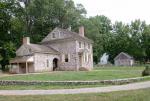![header=[Marker Text] body=[Village settled by the workers at iron forge begun in 1742. The forge and part of village were burned by the British army in 1777. Washington's quarters during the winter of 1777-78 were in the Isaac Potts house, a part of the original village. Dedicated: September 17, 1960. ] sign](http://explorepahistory.com/kora/files/1/10/1-A-E4-139-ExplorePAHistory-a0a4b7-a_450.gif)
Mouse over for marker text
Name:
Village of Valley Forge
Region:
Philadelphia and its Countryside/Lehigh Valley
County:
Chester
Marker Location:
PA 23 E & W of village
Dedication Date:
September 17, 1960
Behind the Marker
The dramatic story of the hardships faced by the Continental Army at Valley Forge is part of Americans' national mythology. Official records indicate that at least eight to ten soldiers deserted every day during the harsh winter of 1777-78. Yet historians like Charles Royster have pointed out that Valley Forge was important for reasons beyond the grim courage of the soldiers who stayed through the bitter winter. It was the first winter encampment to introduce comprehensive military training to American infantrymen through the efforts of the former Prussian officer Baron von Steuben.
Washington selected the village, formerly known as Mount Joy Forge, for its location, since it was further away from British-occupied Philadelphia than his previous position at Whitemarsh, but not too distant to prevent monitoring possible enemy troop movements.
There is controversy over the claim that the Isaac Potts home served as Washington's Valley Forge headquarters. The editors of the Washington Papers at the Library of Congress state bluntly that "no evidence" exists in his records to document the claim, insisting that the association "appears to rest largely upon tradition" and the "recollection of aged individuals." As the marker text suggests, prior to the arrival of the Americans, a British raiding party had destroyed several buildings at Valley Forge. There could not have been too many inhabitable residences from which the commander in chief could select his headquarters.
The general's expense accounts indicate that he left his tent on Christmas Day 1777 to establish more permanent quarters at the home of Deborah Hewes, a widow. Isaac Potts himself was not then present at the Forge, living instead at nearby Pottsgrove. Records from the period also suggest that William Dewees, who had married into the Potts family, was actually considered the owner and operator of Valley Forge during the wartime period.
Washington selected the village, formerly known as Mount Joy Forge, for its location, since it was further away from British-occupied Philadelphia than his previous position at Whitemarsh, but not too distant to prevent monitoring possible enemy troop movements.
There is controversy over the claim that the Isaac Potts home served as Washington's Valley Forge headquarters. The editors of the Washington Papers at the Library of Congress state bluntly that "no evidence" exists in his records to document the claim, insisting that the association "appears to rest largely upon tradition" and the "recollection of aged individuals." As the marker text suggests, prior to the arrival of the Americans, a British raiding party had destroyed several buildings at Valley Forge. There could not have been too many inhabitable residences from which the commander in chief could select his headquarters.
The general's expense accounts indicate that he left his tent on Christmas Day 1777 to establish more permanent quarters at the home of Deborah Hewes, a widow. Isaac Potts himself was not then present at the Forge, living instead at nearby Pottsgrove. Records from the period also suggest that William Dewees, who had married into the Potts family, was actually considered the owner and operator of Valley Forge during the wartime period.
Beyond the Marker






